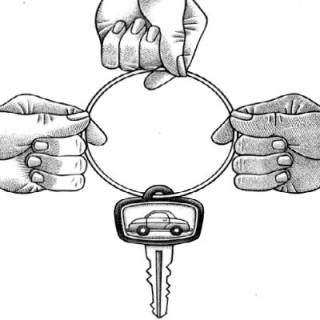Read an excerpt from this article below. You can download the full article by using the link at the end of the excerpt.
What would you do if someone offered you, in exchange for your car, access to a pay-by-the-hour car anytime you wanted it? What could you do with all that money you’re spending on car loan payments, insurance, gas, maintenance, and parking? What could your community do with the land for parking spaces and roadway lanes required to support your need to drive your own car everywhere? It’s worth considering.
What Is Car Sharing?

Car sharing is a service that provides members with access to a fleet of vehicles on an hourly basis. Members reserve a car online or by phone, then walk or take transit to the parking space where the nearest car is located. In most programs, members are provided with an electronic key card that opens the car door. Typically, members are billed monthly for time and/or mileage.
The precursor of today’s car sharing programs can apparently be traced back to a car sharing arrangement developed by a Zurich, Switzerland, housing cooperative in the late 1940s. But the kind of car sharing programs I’ll be discussing have their roots in European programs of the late 1980s and early 90s, such as Mobility Switzerland, one of the world’s largest car sharing operation — with a fleet of 1,950 cars in some 1,050 locations, and more than 73,000 members.
American car sharing began in Portland, Oregon, in 1998. Over the past ten years, car sharing has taken off, with estimates of some 250,000 car share users today in the U.S. and Canada.
Car sharing is usually run by either for-profit operators, such as Zipcar; or by non-profit groups such as San Francisco’s City Car Share, Philly CarShare, or Chicago’s I-GO. According to a guide from City CarShare, regardless of size or organizational structure, the essential features of most car sharing programs include:
- Short-term use. Car sharing charges by the hour, and/or the mile as well, making short trips cost-effective.
- Neighborhood-based, distributed vehicle locations. Car sharing operators place “pods” or points of departure of one to (usually) three or four vehicles at locations all around a city, ensuring they are within an easy walk of as many people as possible. The cars have reserved spaces in parking garages, on the street, or at transit stations.
- Unattended or self-accessing. Members reserve a car online or by telephone, open the doors with their own electronic key, and return the car without ever dealing with anyone else.
- Turnkey service. Car sharing services include fuel, maintenance, insurance, and reserved parking at the pod. This saves members money and allows them to “out-source” the chores of ownership.What Difference Can Car Sharing Make?
Perhaps the most obvious incentive for prospective car-sharers is the cost savings they can realize by giving up their car. AAA data from 2006 indicates the average annual cost Americans face to own and operate a passenger vehicle at $7,834 — and that was based on $2.405/gallon gas prices, a distant memory today.
Car sharing programs offer a number of benefits to communities as a whole, all stemming from the fact that car sharers drive less often and own fewer cars. According to Zipcar’s Kristina Kennedy, “forty percent of Zipcar’s members report selling a car or changing/postponing a purchasing decision.” With its 180,000 members, this obviously has a significant impact on the number of vehicles on the road. As Kennedy points out, Zipcar’s 5,500 car fleet has, in effect, substituted for roughly 72,000 cars sold or not purchased by its member.
The 8,000 members of Chicago’s non-profit I-GO car sharing program have made comparable choices. As I-GO CEO Sharon Feigon told us, “46 percent of our members either sell a car or postpone a decision to buy one as a result of the program.” In a sign of its strong growth, I-GO will be adding 50 cars in 2008 to its existing fleet of 170 cars.
End of excerpt
… article continues with more detailed look at community benefits from car sharing, followed by sections on: Who Uses Car Sharing?; Where Does Car Sharing Succeed?; and Thinking About a Program in Your Community?
With sidebars on how car sharing works in Arlington County, Virginia, and why car sharing didn’t work in Traverse City, Michigan.
Hannah Twaddell is President and founder of Twaddell Associates, LLC, a consulting practice specializing in community planning, public engagement, facilitation, and education. Based in Charlottesville, Virginia, the firm provides planning, facilitation, and educational services to communities, government agencies, and private organizations across the U.S.
Before setting up Twaddell Associates, Hannah was a Senior Transportation Planner with Renaissance Planning Group, where she has worked on transportation planning and public involvement projects in several states. Prior to that, she served as Assistant Director of the Thomas Jefferson Planning District Commission (in Charlottesville) and as chief staff to the Charlottesville-Albemarle Metropolitan Planning Organization.